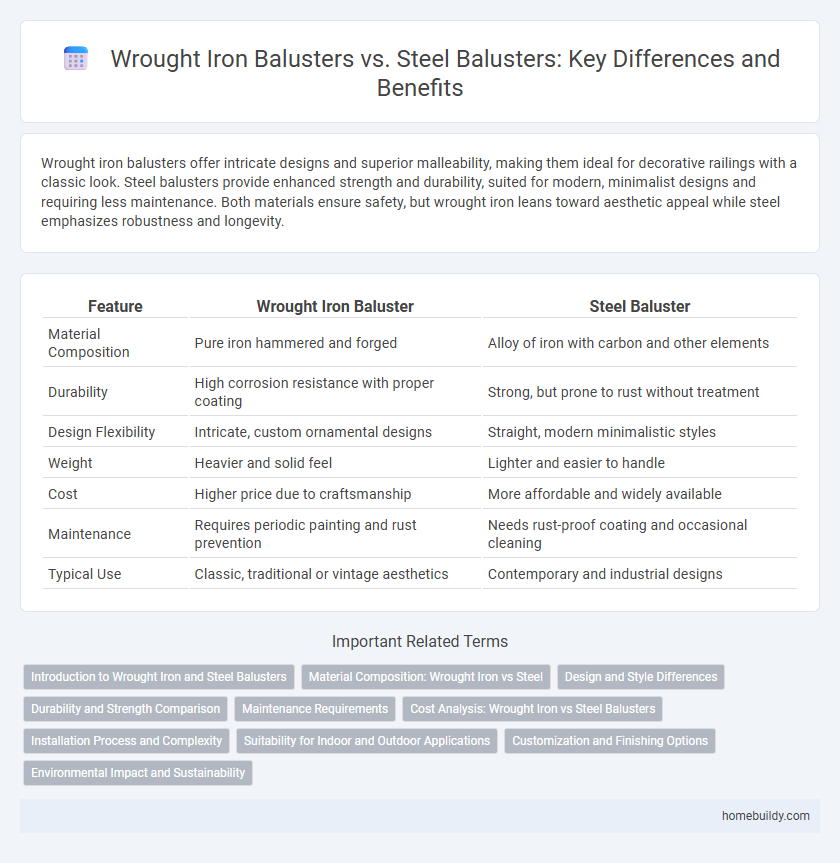Wrought iron balusters offer intricate designs and superior malleability, making them ideal for decorative railings with a classic look. Steel balusters provide enhanced strength and durability, suited for modern, minimalist designs and requiring less maintenance. Both materials ensure safety, but wrought iron leans toward aesthetic appeal while steel emphasizes robustness and longevity.
Table of Comparison
| Feature | Wrought Iron Baluster | Steel Baluster |
|---|---|---|
| Material Composition | Pure iron hammered and forged | Alloy of iron with carbon and other elements |
| Durability | High corrosion resistance with proper coating | Strong, but prone to rust without treatment |
| Design Flexibility | Intricate, custom ornamental designs | Straight, modern minimalistic styles |
| Weight | Heavier and solid feel | Lighter and easier to handle |
| Cost | Higher price due to craftsmanship | More affordable and widely available |
| Maintenance | Requires periodic painting and rust prevention | Needs rust-proof coating and occasional cleaning |
| Typical Use | Classic, traditional or vintage aesthetics | Contemporary and industrial designs |
Introduction to Wrought Iron and Steel Balusters
Wrought iron balusters are renowned for their classic, handcrafted appearance and exceptional malleability, allowing intricate designs that enhance architectural aesthetics. Steel balusters offer superior strength and durability, with modern manufacturing techniques enabling a sleek, uniform finish often favored in contemporary settings. Both materials provide structural support and decorative appeal, but wrought iron emphasizes ornamental artistry while steel emphasizes resilience and low maintenance.
Material Composition: Wrought Iron vs Steel
Wrought iron balusters consist primarily of iron with a very low carbon content and small amounts of slag, giving them a fibrous texture that enhances corrosion resistance and malleability. Steel balusters are made from iron alloys with higher carbon content, offering greater strength and durability but less flexibility compared to wrought iron. The distinct material composition impacts the baluster's performance, with wrought iron favoring decorative applications due to its intricate workability, while steel suits structural uses requiring higher load-bearing capacity.
Design and Style Differences
Wrought iron balusters offer intricate, handcrafted designs showcasing classic elegance with ornate scrollwork and custom patterns, which often convey a timeless, traditional aesthetic. Steel balusters, in contrast, provide a sleek, modern look with clean lines and minimalist styles, making them ideal for contemporary architectural themes. The choice between wrought iron and steel balusters significantly influences the overall design language, balancing decorative artistry with structural simplicity.
Durability and Strength Comparison
Wrought iron balusters demonstrate superior durability due to their high resistance to corrosion and inherent flexibility, reducing the risk of cracking under stress. Steel balusters, while strong and cost-effective, may be prone to rust and require protective coatings to maintain longevity. The choice hinges on balancing wrought iron's long-lasting strength with steel's affordability and ease of maintenance.
Maintenance Requirements
Wrought iron balusters require regular maintenance including rust prevention treatments, repainting every few years, and occasional repairs for corrosion-prone areas to preserve their decorative appeal. Steel balusters offer lower maintenance demands due to their corrosion-resistant coatings and durability, requiring only periodic inspections and touch-ups to maintain structural integrity. Choosing steel balusters reduces long-term maintenance costs and labor compared to wrought iron alternatives.
Cost Analysis: Wrought Iron vs Steel Balusters
Wrought iron balusters typically cost more due to intricate craftsmanship and higher material costs, ranging from $30 to $100 per piece compared to steel balusters, which average $10 to $30. Steel balusters offer a cost-effective alternative with easier manufacturing and lower raw material prices, making them suitable for budget-conscious projects. Maintenance expenses also influence total cost, as wrought iron requires regular treatment to prevent rust, whereas steel balusters coated with powder finish provide enhanced durability and reduced upkeep.
Installation Process and Complexity
Wrought iron balusters require precise hand-forging and custom fitting, making the installation process more labor-intensive and complex compared to steel balusters. Steel balusters are typically pre-fabricated with standardized dimensions, allowing for easier, quicker installation with common tools. The heavier weight and unique shapes of wrought iron often necessitate specialized skills and equipment, increasing time and cost during installation.
Suitability for Indoor and Outdoor Applications
Wrought iron balusters offer superior corrosion resistance and intricate design options, making them ideal for outdoor applications where durability against weather elements is crucial. Steel balusters provide a more budget-friendly solution with high strength, best suited for indoor use due to their susceptibility to rust without protective coatings. Selecting between wrought iron and steel depends on environmental exposure and desired aesthetic longevity for staircases or railings.
Customization and Finishing Options
Wrought iron balusters offer exceptional customization with intricate designs and detailed scrollwork, making them ideal for creating ornate, classic aesthetics. Steel balusters provide a broader range of finishing options, including powder coating and galvanization, enhancing durability and allowing for sleek, modern color choices. Both materials support custom lengths and shapes, but wrought iron excels in artistic craftsmanship while steel prioritizes versatile, low-maintenance finishes.
Environmental Impact and Sustainability
Wrought iron balusters, crafted through traditional forging methods, typically involve higher energy consumption but offer excellent durability and recyclability, reducing long-term environmental impact. Steel balusters, often produced using modern, energy-efficient techniques like cold rolling, have a lower carbon footprint during manufacturing and are highly recyclable, supporting sustainability goals. Both materials contribute to eco-friendly construction by minimizing waste and promoting reuse, yet steel's widespread availability and efficient production processes often make it the more sustainable option overall.
wrought iron baluster vs steel baluster Infographic

 homebuildy.com
homebuildy.com